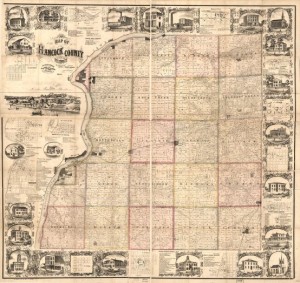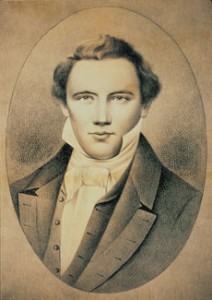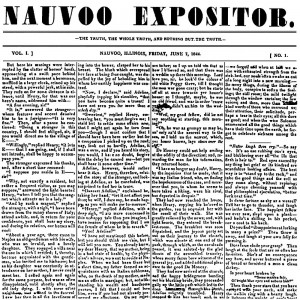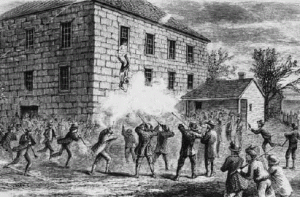Rachel Daigle
Introduction
In 1839, a beleaguered, exiled group known as the Church of Latter Day Saints of Jesus Christ—also known as the Mormons—crossed the Missouri border into Jackson County, Illinois. Fleeing from years of violent persecution by non-Mormons, the Mormons set up the city of Nauvoo under the aegis of their prophet, Joseph Smith, the founder and first prophet of the Church. The Mormon community was initially welcomed and expanded rapidly into a permanent, thriving center of Mormon religion, but over the course of five years, the Mormons rapidly lost favor with authorities and neighboring towns. Violence and persecution sprang anew among the citizens of Illinois, and in 1844, Joseph Smith and his brother Hyrum were murdered during an anti-Mormon raid at a Carthage jail. Shortly after, under new leadership and duress, the Mormons left Nauvoo for a new home in the West. The rapid rise and decline of Nauvoo, once intended as a paradise in preparation for the millennium, is surrounded in bias and conflict, and it is often seen as an enduring example of religious persecution in America.
This research guide is intended to explore Mormon Nauvoo in its historical context. Its primary focus rests on the controversies arising from and surrounding the Mormon settlement in Illinois; it is by no means a thorough explanation of Mormon theology or society, but it is rather an exploration of Nauvoo’s many roles and interactions on the Illinois frontier. The guide is divided into some of the primary controversies involving the Nauvoo Mormons. It is primarily composed of critical articles and books, though primary sources are represented as well through collections and digital databases. The following sources will provide a close study of Nauvoo in context as one of the most important, controversial religious settlements in American history, as well as provide a stepping stone for further inquiry into religious migrations, persecutions, and histories.
General Sources
The following sources provide broad, comprehensive perspectives on the Mormons and Nauvoo.
Nauvoo: Kingdom on the Mississippi – Robert Bruce Flanders
Flanders’ work explores Nauvoo as a settlement in its entirety. Flanders delves deeply into Nauvoo as both a political and a theological site, led by Smith, who acted as religious, political, and economic leader of the city. Ample consideration is given to Nauvoo as both a city of the earth, with a government, military, and industry, and as Smith’s projected Zion for his people. Flanders analyzes the arrival, the lives, and the transformations of the Mormons, as well as the consequences of the city’s growth and the subsequent conflicts that arose. Flanders provides a holistic view of Nauvoo from a variety of perspectives that provide a thorough exploration of Nauvoo society and its relationship with the non-Mormons of Illinois. This work is very thorough and contains a wealth of vital information.
- Flanders, Robert Bruce. Nauvoo: Kingdom on the Mississippi. Urbana: University of Illinois Press, 1965.
No Man Knows My History: The Life of Joseph Smith, the Mormon Prophet – Fawn Brodie
Brodie’s book on the life of Joseph Smith is considered one of the most comprehensive, in-depth looks at Joseph Smith, the man. It is one of the first books written about Smith from a secular perspective. Brodie explores the course of Smith’s life, the creation of his religion, and his role in its expansion to the Midwest. The book provides not only historical context for the migration to Nauvoo from Missouri, but also a thorough study of Smith’s role at Nauvoo as prophet and, increasingly, political figure. While it may have a greater focus on Smith than on Nauvoo itself, it nevertheless provides valuable information about Nauvoo’s relationship with surrounding towns and the theological and social divisions occurring within the Mormon community itself. It should be noted that Brodie’s book is considered controversial by many inside and outside the religious community. Additional book reviews will provide a more thorough understanding of the most controversial aspects in Brodie’s work.
- Brodie, Fawn M. No Man Knows My History: The Life of Joseph Smith, the Mormon Prophet. New York: A. A. Knopf, 1946.
Exiles in a Land of Liberty: Mormons in America, 1830-1846 – Kenneth H. Winn
Winn tackles the question of the causes and consequences of early Mormon persecution in America. He frames the hostilities of non-Mormons and Mormons in terms of republican ideology and the question of early American civic virtue. Winn’s work encompasses a variety of historical perspectives and is a very thorough study of the persecution specific to the Mormons. Chapters 8-10 deal most explicitly with the ideologies and events associated with Nauvoo, but the preceding chapters provide very useful background to the transformation of Mormon political and theological thought.
- Winn, Kenneth H. Exiles in a Land of Liberty: Mormons in America, 1830-1846. Chapel Hill: University of North Carolina Press, 1989.
The Historians and Mormon Nauvoo – Richard L. Bushman
Bushman’s article studies the approaches that historians, Mormons, and non-Mormons alike have taken towards understanding and interpreting the events at Nauvoo. It is a useful tool for considering the lenses through which students of Mormon history have seen Nauvoo.
- Bushman, Richard L. “The Historians and Mormon Nauvoo.” Dialogue: A Journal of Mormon Thought 5 (1970): 51-61.
Primary Source Collections
Cultures in Conflict: A Documentary History of the Mormon War in Illinois – John E. Hallwas & Roger D. Launius
Cultures in Conflict takes a documentary, chronological approach to the conflict at Nauvoo through the use of many of the most important primary sources from both Mormon and non-Mormon perspectives. Hallwas and Launius attempt to present a cultural context without a religious bias and approach the catalyst of the controversies as a conflict primarily of ideologies. By collecting these primary sources and interpreting them, the authors provide an invaluable source of contemporary information that fleshes out and contextualizes the Mormon narrative at Nauvoo.
- Hallwas, John E., and Roger D. Launius. Cultures in Conflict: A Documentary History of the Mormon War in Illinois. Logan: Utah State University Press, 1995.
Among the Mormons: Historic Accounts by Contemporary Observers – William Mulder & A. Russell Mortenson
Mulder and Mortenson take a similar approach by gathering primary sources for the viewer’s own interpretation, but encompass a much broader spectrum. These sources address the rumors and truths surrounding Mormons from their origins to their settlement in Utah. This is a wide cross section of documents about Mormon history, but it includes several accounts about Nauvoo society as well as the aftermath of Joseph Smith’s murder. It supplements narrower collections of primary sources, provides contextual evidence, and creates an entry point for further exploration into Mormon documentary history.
- Mulder, William, and A. Russell Mortenson. Among the Mormons: Historic Accounts by Contemporary Observers. New York: Knopf, 1958.
Thomas Sharp and Anti-Mormon Sentiment in Illinois, 1842-1845 – Annette P. Hampshire
Hampshire’s brief article is a collection of personal letters by Thomas Sharp and other anti-Mormons in Illinois. This compilation is small and has a narrow focus, but it provides several primary sources that document the sentiments and considerations of anti-Mormons before and after the death of the prophet. The collection itself can also be viewed here.
- Hampshire, Annette P. “Thomas Sharp and Anti-Mormon Sentiment in Illinois, 1842-1845.” Journal of the Illinois State Historical Society (1908-1984) 72, no. 2 (1979): 82-100.
Politics and Theology
God and the People: Theodemocracy in Nineteenth Century Mormonism – Patrick Q. Mason
Mason’s article studies of the role of religion in Mormon politics. He follows the chronology of Mormon political views, pinpointing Navuoo as the site of a major transformation of Mormon earthly aspirations. The Mormons’ entry into politics, he argues, arose from the need to protect themselves from persecution. Mason explores the formation of the Mormon theodemocratic model, its roots in Mormon religious views, and its legacy in later periods of Mormon history.
- Mason, Patrick Q. “God and the People: Theodemocracy in Nineteenth Century Mormonism.” Oxford Journal of Church and State 53, no. 3 (January 28, 2011): 349-75.
Quest for Refuge: An Hypothesis as to the Social Origins and Nature of the Mormon Political Kingdom – Marvin S. Hill
Hill also emphasizes the development of the Mormon political kingdom out of rural, millennial, religious views. This political dimension of the Mormon religion was born, Hill claims, from the government’s failure to protect the Mormon people from harsh persecution in Missouri; the Mormon political-religious model became a measure of safety and protection from a harsh outer world. Hill briefly applies the idea of the kingdom to Nauvoo and outlines Smith’s political ambitions as defensive maneuvers for his people.
- Hill, Marvin S. “Quest for Refuge: An Hypothesis as to the Social Origins and Nature of the Mormon Political Kingdom.” Journal of Mormon History 2 (1975): 3-20.
Mormon Nauvoo from a non-Mormon Perspective – John E. Hallwas
Hallwas reinforces the importance of theology in Mormon politics and pursues an understanding of Nauvoo from the eyes of the surrounding non-Mormons. He regards the conflict at Nauvoo as a conflict of differing ideologies about democracy on the frontier. By reminding the viewer of the relative novelty of democracy on the freshly forming frontier, Hallwas contextualizes the struggle between Mormon theologically-oriented democratic ideals and more traditional non-religious democracy. He defines the entire struggle not as an episode of persecution but as a conflict of ideas regarding the rights of the majority and minority under democratic rule.
- Hallwas, John E. “Mormon Nauvoo from a non-Mormon Perspective.” Journal of Mormon History 16 (1990): 53-69.
The Kingdom of God in Illinois: Politics in Utopia – Robert Bruce Flanders
This brief article by the author of Nauvoo: Kingdom on the Mississippi explores Nauvoo’s millenarian expansionist dreams in the context of surrounding settlements. Here, Flanders considers the religious motivations behind Nauvoo’s political aspirations and how those dreams of an earthly Zion gave rise to conflict with other Illinois towns who disagreed with and felt threatened by the possibility of Mormon political hegemony.
- Flanders, Robert Bruce. “The Kingdom of God in Illinois: Politics in Utopia.” Dialogue: A Journal of Mormon Thought 5 (1970): 26-36.
Mormon Political Reach
The Mormons and Politics in Illinois Society: 1839-1844 – George R. Gayler
In this article, Gayler thoroughly studies Mormon political movements and associations in Nauvoo. He argues that the violent reaction of non-Mormon Illinois citizens to the Mormons was a result of Mormon involvement and attitudes in politics, not of controversial religious or economic views. The apparent policy of the Mormon bloc vote and Smith’s intention to remain part of the volatile political sphere played a pivotal role, Gayler believes, in the hostility towards Mormon Nauvoo.
- Gayler, George R. “The Mormons and Politics in Illinois Society: 1839-1844.” Journal of the Illinois State Historical Society 49, no. 1 (1956): 48-66.
Anti-Mormon Mob Violence and the Rhetoric of Law and Order in Early Mormon History – Marie H. Nelson
Nelson’s article considers the roles of law, order, democracy, and the government in the violent reaction to Mormon growth in Illinois. She takes special note of the roots of anti-Mormon violence and its relation to establishing dominant cultural authority within the problem of majority/minority rights. This is a very thorough and well-written article about secular clashes of Mormons and non-Mormons.
- Nelson, Marie H. “Anti-Mormon Mob Violence and the Rhetoric of Law and Order in Early Mormon History.” The Legal Studies Forum 21 (1997): 353-88.
A Wall to Defend Zion: The Nauvoo Charter – James L. Kimball Jr.
Kimball’s article examines the formation of the Nauvoo charter, the document outlining Nauvoo’s legal powers as a legitimate city, and the possible consequences of its contents. Kimball argues that the powers delineated in the charter isolated the Mormons from their neighbors by giving them possibly excessive powerful hegemony over their settlement as an entity separate from the state. The article also recognizes the role of the charter as an attempted realization of the Mormon political-theological kingdom.
- Kimball Jr, James L. “A Wall to Defend Zion: The Nauvoo Charter.” BYU Studies 15, no. 4 (1975): 491-497.
The Nauvoo Legion, 1840-1845: A Unique Military Organization – John C. Bennett, Hamilton Gardner, James Shepherd, and James Sloan
This brief article studies the structure and potentially controversial powers of the Nauvoo Legion, the local militia of Nauvoo. This article provides a better understanding of the Legion itself and of its influence inside and outside the Nauvoo community. It is a narrow topic that would best be used in conjunction with wider currents of conflict.
- Bennett, John C., Hamilton Gardner, James Sloan, and James Shepherd. “The Nauvoo Legion, 1840-1845: A Unique Military Organization.” Journal of the Illinois State Historical Society 54, no. 2 (1961): 181-97.
The Suppression of the “Nauvoo Expositor” – Dallin H. Oaks
Oaks’ article delves into the issue of the destruction of the Nauvoo Expositor, a short-lived newspaper whose only issue attempted to expose and defame the falsehoods of Smith’s Mormonism. His article not only studies the legality of Smith’s order to destroy the press, but also points out the destruction of the Nauvoo Expositor as the ignition for a series of mounting tensions both within and outside the Mormon community at Nauvoo that eventually led to Smith’s violent death. The importance of the document itself is discussed below.
- Oaks, Dallin H. “The Suppression of the Nauvoo Expositor.” Utah Law Review, 9 (1964): 862-903
Religion and Nauvoo
Nauvoo Expositor – William Law et al.
The Nauvoo Expositor is the first and only issue of a dissenting newspaper in Carthage, Illinois. The newspaper is an attempt by Mormons cast out of Joseph Smith’s society to expose the errors and heresies in Smith’s doctrine. It serves as a contemporary example of strife within the Mormon community about the viability of Smith’s doctrine and ideal society. Its most important role, arguably, was that Smith’s order for its destruction led to his arrest, which in turn led to his death. The entire source can be viewed here.
- William Law et al. Nauvoo Expositor. Carthage, Illinois, 1844
Mormon Religion in Nauvoo: Some Reflections – Marvin S. Hill
Hill provides important background information about the character and transformations of Mormon theology at Nauvoo. For a more thorough analysis of the consequences of Nauvoo’s new theological tenets, this source is best considered in context with more detailed articles and books.
- Hill, Marvin S. “Mormon Religion in Nauvoo: Some Reflections.” Utah Historical Quarterly 44 (1976): 170-80.
“Dictated by Christ”: Joseph Smith and the Politics of Revelation – Steven C. Harper
Harper’s article examines the role of Joseph Smith’s religious revelations in the creation of Nauvoo and the community’s involvement in the political sphere. His discussion of Nauvoo in particular begins on page 296, but the previous pages provide ample background for the attitudes of the Mormons and the weight of Smith’s revelations.
- Harper, Steven C. “”Dictated by Christ”: Joseph Smith and the Politics of Revelation.” Journal of the Early Republic 26, no. 2 (2006): 275-304.
Revelation, Resistance, and Mormon Polygamy: The Introduction and Implementation of the Principle, 1830-1853. – Merina Smith
Merina Smith’s book offers an in-depth look into the early construction and implementation of the Mormon principle of “celestial marriage,” also known as plural marriage or polygamy. She closely studies the theological principles underlying plural marriage in Mormonism and considers the controversial transformations it underwent in Nauvoo to turn it into a widely accepted and often vehemently defended practice in the late nineteenth century. Smith recognizes that the amount of information regarding secret polygamy in Nauvoo is scarce, but she is able to analyze what material she does have coherently and professionally.
- Smith, Merina. Revelation, Resistance, and Mormon Polygamy: The Introduction and Implementation of the Principle, 1830-1853. Logan: Utah State University, 2013.
Nauvoo Roots of Mormon Polygamy, 1841–46: A Preliminary Demographic Report – George D. Smith
George Smith also addresses polygamy as one of the more controversial and poorly understood tenets of Mormonism. He explores its true meaning and charts its early path within the Mormon community before discussing its possible ramifications for Joseph Smith and for Nauvoo itself. The author admits that the early implementation of polygamy is not well documented, but he makes a fair historical assessment of the information he does have.
- Smith, George D. “Nauvoo Roots of Mormon Polygamy, 1841–46: A Preliminary Demographic Report.” Dialogue: A Journal of Mormon Thought 27, no. 1 (1994): 1-36.
A Little-known Defense of Polygamy from the Mormon Press in 1842 – Lawrence Foster
Foster’s article explores the little-known birth of polygamy in Nauvoo through a document printed in 1842, published by Joseph Smith, that set forth a possible early advocacy for plural marriage. Foster also studies the social problems associated with the implementation of plural marriage and the reasons for its internal and external controversies. The author makes good use of a primary source to delve into a shadowy and uncertain topic.
- Foster, Lawrence. “A Little-known Defense of Polygamy from the Mormon Press in 1842.” Dialogue: A Journal of Mormon Thought 9: 21-34.
The City of the Mormons; or, Three Days at Nauvoo, in 1842 – Henry Caswall
This is a primary source written by a visitor to Nauvoo in 1842. The author’s inherent hostility and comprehensive condemnation of Mormon doctrine is blatantly biased, but it serves well as an example of the contemporary controversy raised over Mormon theology and its place in a world of Christian hegemony.
- Caswall, Henry. The City of the Mormons; or, Three Days at Nauvoo, in 1842. London: J. G. F. & J. Rivington, 1842.
Death of Joseph Smith
Carthage Conspiracy: The Trial of the Accused Assassins of Joseph Smith – Marvin S. Hill & Dallin H. Oaks
This source is an attempt in secular scholarship to detail the circumstances and reasons behind the death of Joseph Smith through the lens of his accused murderers. The authors frame the death in terms of differing ideas of frontier democracy and center their study on the trial of the accused to draw conclusions. The source recognizes some liberal narrative within itself, but it has thorough footnotes, research, and a strong attempt at removing potential Mormon bias from its study of the proceedings.
- Hill, Marvin S. and Dallin H. Oaks. Carthage Conspiracy: The Trial of the Accused Assassins of Joseph Smith. University of Illinois Press, 1979.
Governor Thomas Ford and the Murderers of Joseph Smith – Keith Huntress
Huntress looks specifically at the role of the governor in the circumstances leading to and following Joseph Smith’s death. He notes the standard definitions of Ford’s role and attempts to flesh out his actions in a non-biased, historically contextual fashion. Huntress’ article provides a close analysis of a single aspect of Smith’s death that has not been thoroughly explored and can be connected to larger currents within Illinois society.
- Huntress, Keith. “Governor Thomas Ford and the Murderers of Joseph Smith.” Dialogue. A Journal of Mormon Thought 4 (1969): 41-52.
Carthage Conspiracy Reconsidered: A Second Look at the Murder of Joseph and Hyrum Smith – Marvin S. Hill
Hill’s article studies the death of Joseph and Hyrum Smith in the context of the numerous rising conflicts between Mormon Nauvoo and non-Mormon Illinois settlements who felt threatened by the Mormons’ growth. Hill considers both political and religious reasons for large-scale hostility towards Smith and his community, which then culminated in the murder of the prophet. This is a good contextualizing source about the murder that clearly connects the death with broader societal factors. It is also a more recent reconsideration of his older work, Carthage Conspiracy.
- Hill, Marvin S. “Carthage Conspiracy Reconsidered: A Second Look at the Murder of Joseph and Hyrum Smith.” Journal of the Illinois State Historical Society 97, no. 2 (2004): 107-34.
Junius and Joseph: Presidential Politics and the Assassination of the First Mormon Prophet – Fred Foister & Robert Wicks
Foister and Wicks take a different approach to Smith’s death by studying it as a carefully planned conspiracy to assassinate the prophet rather than as the sad result of spontaneous mob violence. The presentation of the book is arguably heavy-handed and emphatically certain of its conclusion to the point of excluding other interpretations. As such, the reader must be aware of some Mormon-oriented bias. In spite of the problematic aspects, however, the book does provide detailed information regarding the murder and contemporary Illinois society.
- Foister, Fred, and Robert Wicks. Junius and Joseph: Presidential Politics and the Assassination of the First Mormon Prophet. Logan: Utah State University, 2005.
From Assassination to Expulsion: Two Years of Distrust, Hostility, and Violence – Marshall Hamilton
Hamilton’s work looks at a decidedly under-studied period of Mormon history: the two years at Nauvoo following Smith’s death. This article affirms the continuation of Mormon strife in Illinois even after the death of the controversial prophet. It is particularly useful because far less study has been devoted to the Mormons at Nauvoo after Smith’s death than before Smith’s death. Hamilton provides useful information about the aftermath of the prophet’s death and the escalation of old conflicts between Mormons and anti-Mormons.
- Hamilton, Marshall. “From Assassination to Expulsion: Two Years of Distrust, Hostility, and Violence.” BYU Studies 32, no. 1 (1992): 229-248.
Databases for Further Research
The Church History Library is a database run by the Mormon Church that contains numerous print and digital resources recording Mormon history since its beginning. The library is, however, a comprehensive collection based in Utah: many of the archival materials may not be viewable online and many are print materials. The site is still a good source of information and a good starting point for more thorough research. Searching the “Archives” tab will yield the most relevant results.
Church History Library (Internet Archive)
This online archive is the host site for the Church’s primary sources. Any of the digitized primary sources found in the library catalog above will link to this site. It has a comprehensive selection of documents across a wide span of time and a useful tagging system which allows for quick, easy access to the documents associated with a particular topic or individual. This site contains only primary sources, and it is very easy to locate significant documents.
Times and Seasons was the Nauvoo paper published by the Mormons during their stay in Illinois. It is hosted here in the Brigham Young University Digital Collections. These issues provide a wealth of internal information about the Nauvoo settlement regarding its religious practices, its social growth, and its role on the Illinois frontier.
Illinois Digital Newspaper Collections
This site is a collection of digitized Illinois newspapers from 1831 to the present. A search for Nauvoo will reveal several contemporary documents, primarily from non-Mormon papers, that shed more light on the happenings at Nauvoo and after the departure of the Mormons.




